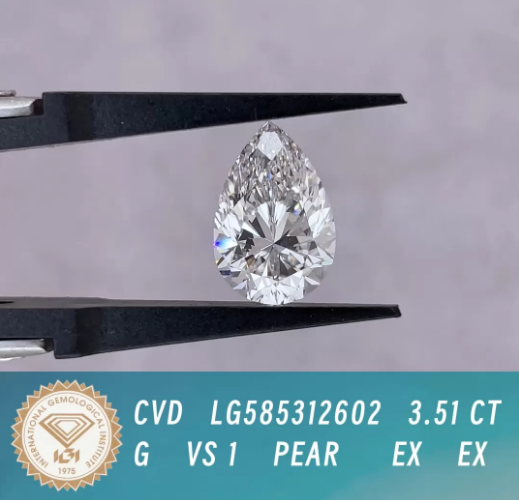What Are Lab Grown Diamonds?
Lab-grown diamonds, alternatively termed lab-created, man-made, engineered, or cultured diamonds, are produced within precisely controlled laboratory settings. Employing advanced technological procedures, these labs replicate the natural conditions wherein diamonds typically originate—forming within the Earth's mantle beneath its crust. These lab-created diamonds are composed of genuine carbon atoms structured in the distinct crystalline pattern characteristic of diamonds. Due to their identical material composition to natural diamonds, they showcase comparable optical and chemical properties.
How Are Lab Grown Diamonds Produced?
Lab-grown diamonds originate from minute carbon seeds derived from existing diamonds. Utilizing cutting-edge technology, scientists employ either extreme pressure and heat or a specialized deposition process called chemical vapor deposition (CVD) to replicate the natural diamond formation method. Within a span of six to ten weeks, a rough diamond is cultivated, subsequently undergoing cutting, polishing, and setting into lab diamond jewelry such as earrings, necklaces, or bracelets.

There exist two primary techniques for creating lab diamonds:
1. High-Pressure High Temperature (HPHT): This method mirrors the conditions conducive to natural diamond formation deep within the Earth. A substantial machine is supplied with a specific quantity of carbon material, which it then crushes under pressures exceeding 870,000 pounds per square inch, at temperatures ranging between 1300 and 1600 degrees Celsius.
2. Chemical Vapor Deposition (CVD): In the CVD process, a seed diamond is situated within a compact, vacuum chamber containing heated hydrogen and carbon-based gases. At a predetermined temperature, the gas molecules break down, leading to the accumulation of crystallized carbon layers around the seed, resulting in the growth of a larger diamond. Some lab diamonds produced via CVD might also undergo subsequent pressure and heat treatments after cultivation.
Distinguishing natural diamonds from lab diamonds produced via the HPHT or CVD methods is impossible to the naked eye; only scientists can discern the discrepancies by analyzing distinctive markers induced by the growth conditions.
Lab Grown Diamonds vs. Natural Diamonds
To the unaided eye, distinguishing between a lab-grown and a natural diamond is impossible—they appear identical. The primary disparity lies in their origin: one is naturally formed deep within the Earth, while the other is cultivated within a laboratory setting.
Lab-created diamonds are grown in controlled environments, while natural diamonds form naturally in the Earth's mantle. Chemically and physically, They are chemically, physically, and optically identical to natural diamonds, with the same hardness, brilliance, and fire.
Our lab-grown diamonds showcase identical physical, chemical, and optical traits as natural diamonds, exuding the same brilliance, sparkle, and scintillation. While lab-created diamonds may contain different trace elements compared to natural ones, these variations do not impact the diamond's visual appearance. The differentiation between lab-created and natural diamonds necessitates specialized equipment and tests for accurate identification.
Lab Grown Diamonds vs. Moissanites vs. Cubic Zirconia
It's crucial to differentiate between lab-grown diamonds and diamond simulants. Lab diamonds are crafted from carbon, just like natural diamonds, while diamond simulants resemble diamonds but lack true carbon crystals.
Two prevalent diamond simulants are moissanite and cubic zirconia.
Moissanite: Although natural moissanite exists, it's exceptionally rare as it originates from space via meteorites, making the moissanite available for purchase lab-created. While they may closely resemble diamonds, moissanites often exhibit a rainbow glint rather than the brilliant sparkle characteristic of traditional diamonds.
Cubic Zirconia: Cubic zirconia (CZ) is another synthetic crystal sometimes used as a diamond substitute. Although it possesses reasonable durability and sparkle, it falls short in matching the brilliance of diamonds and can display signs of wear over time. It's occasionally used temporarily in jewelry until a more robust stone is added.
Cubic zirconia and moissanite aren't any form of diamonds, despite their visual similarities.
Simulants lack the same chemical and physical properties as natural or lab-created diamonds, thus commanding significantly lower prices. Distinguishing simulants from natural or lab-created diamonds is possible solely by visual inspection.
Natural and lab-created diamonds exhibit thermal conductivity, discernible from cubic zirconia using a handheld diamond tester. However, some lab-created diamonds and certain natural colored diamonds might be mistakenly identified as moissanite with specific diamond testers due to similar electrical conductivity. Nonetheless, gemologists can typically differentiate between diamonds and moissanites by their distinctive refractive properties—moissanites being double refractive and diamonds being single refractive.
Benefits of Lab-Grown Diamonds
Lab-grown diamonds present a remarkable alternative to mined diamonds. Beyond their identical physical attributes, they offer responsible sourcing and enhanced cost-efficiency. Key advantages of lab created diamonds encompass:
1. Reduced defects
2. Enhanced affordability
3. Ability to create unique and rare colors not typically found in nature, thus enabling access to distinctive and coveted pieces
4. Trackable origin sources, ensuring diamonds are ethically sourced from reputable establishments that prioritize fair treatment of workers and communities
5. Utilization of HPHT and CVD lab-grown diamond methods, facilitating the meeting of demands without compromising quality or resorting to detrimental processes
Lab Diamonds by Color
Our lab-created diamonds are accessible in diverse colorless ranges. Additionally, we provide lab diamonds in fancy colors, which are exceptionally rare in nature, including sought-after vivid yellows, blues, and pinks. Man-made fancy colored diamonds are developed when minute amounts of particular trace elements are incorporated during the growth stage of the created diamond, mirroring natural processes. Fancy colored lab created diamonds are available at more budget-friendly prices compared to their naturally occurring colored diamond equivalents.



 Lab Grown Emerald
Lab Grown Emerald


